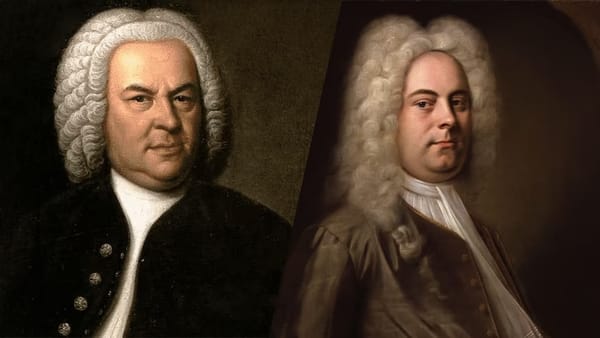Bharatanatyam: A Living Heritage, an Enduring Legacy
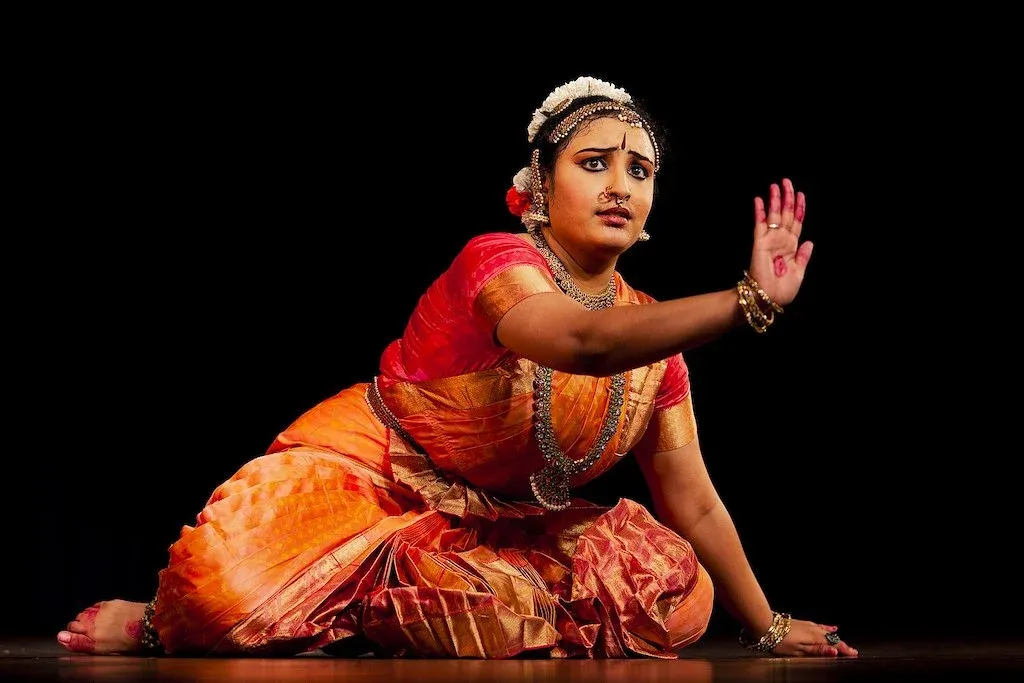
Bharatanatyam, an exquisite classical dance form, traces its origins back to the temples of Tamil Nadu in South India. With a history deeply rooted in the cultural fabric of the region, Bharatanatyam has evolved over centuries, undergoing transformations that have shaped its present-day form.
Origins
The Ancient Temple Dances
To truly understand Bharatanatyam, we must journey back to the ancient era when it originated as a temple dance known as “Sadhir.” In the temples of Tamil Nadu, Devadasis, female temple dancers, dedicated their lives to serving deities through dance. Sadhir was performed as a devotional offering, serving as a means of communication between the devotees and the divine.
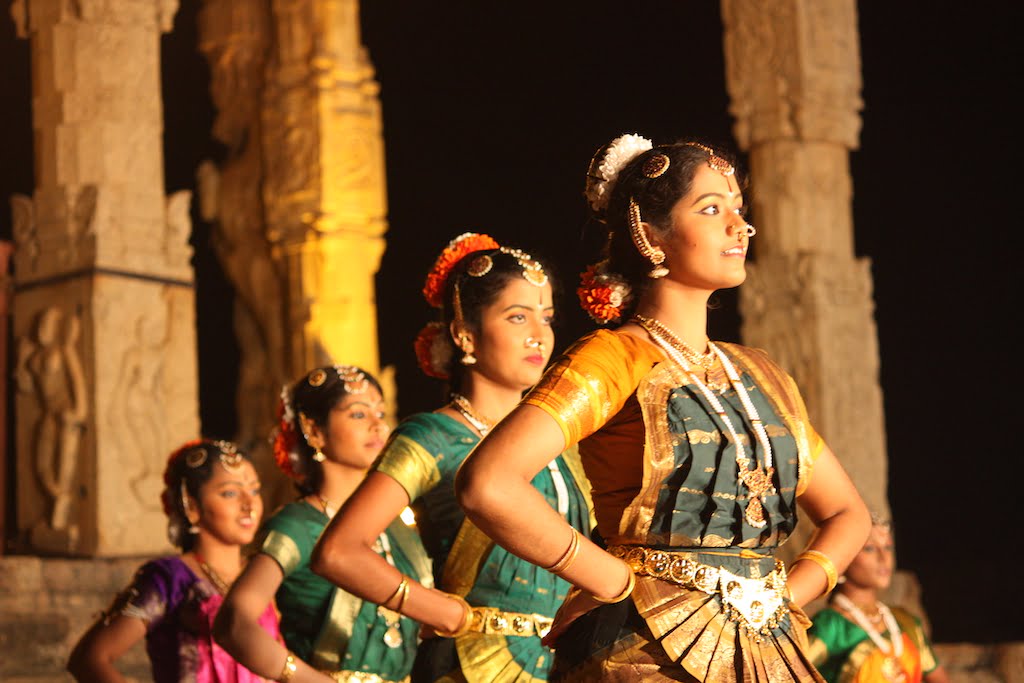
Cultural Influences and Dynastic Patronage
Over time, Bharatanatyam was influenced by various dynasties and cultural developments. The Cholas, Pallavas, and Nayakas played pivotal roles in nurturing and propagating this art form. The Cholas, in particular, were ardent patrons of the arts, and their reign marked a significant period of growth for Bharatanatyam. The Nayakas of Vijayanagara Empire further encouraged the dance form, leading to its spread across different regions.
Devadasi Tradition and Social Shifts
The Devadasi system played a crucial role in the evolution of Bharatanatyam. Devadasis were revered as repositories of artistic knowledge and were responsible for preserving and propagating the dance form. However, social and political changes during the British colonial era brought about a decline in the Devadasi tradition, affecting Bharatanatyam’s practice and perception.
Revival and Transformation
In the early 20th century, Bharatanatyam underwent a significant transformation through the efforts of visionary artists and reformers. Rukmini Devi Arundale, E. Krishna Iyer, and others played instrumental roles in reviving and reshaping Bharatanatyam to suit the changing societal norms and aesthetics. They worked tirelessly to remove the stigma associated with the art form and elevate its status as a revered classical dance.
Contemporary Bharatanatyam
Today, Bharatanatyam is recognized as one of India’s most prominent classical dance forms and enjoys a global following. It has evolved from its devotional roots to encompass themes from mythology, epics, and literature. Contemporary Bharatanatyam embraces innovation while preserving its rich heritage, allowing for creative expressions that resonate with modern sensibilities.
Bharatanatyam’s journey from the temple courtyards to the proscenium stage is a testament to its enduring legacy. The dance form has withstood the test of time, adapting to changing socio-cultural dynamics while retaining its essential essence. In the next part, we will explore the intricate elements that define Bharatanatyam and make it a captivating art form.
Elements of Bharatanatyam: Nritta, Nritya, and Natya
Bharatanatyam, renowned for its grace, precision, and expressive storytelling, encompasses three vital elements: Nritta, Nritya, and Natya. Together, these elements form the foundation of Bharatanatyam and contribute to its mesmerizing appeal.
Nritta: The Pure Dance
Nritta, the technical aspect of Bharatanatyam, focuses on rhythmic patterns, intricate footwork, and geometric poses. It is a pure dance form, devoid of storytelling or emotional expressions. Nritta showcases the dancer’s mastery over precise movements, showcasing their agility, coordination, and control. The dancer performs a series of adavus, which are fundamental dance units, seamlessly blending them together in a synchronized manner. The rhythmic patterns (tala) and beats (jathi) bring vibrancy and energy to the nritta aspect of Bharatanatyam.
Nritya: The Expressive Dance
Nritya explores the expressive aspect of Bharatanatyam, where the dancer brings emotions and narratives to life. Through the effective use of hand gestures (mudras), facial expressions (abhinaya), and body language, the dancer communicates and portrays various characters, stories, and emotions. The art of abhinaya involves conveying a range of emotions, from joy and love to sorrow and anger. Nritya allows the dancer to delve into the depth of emotions and captivate the audience through their portrayal.
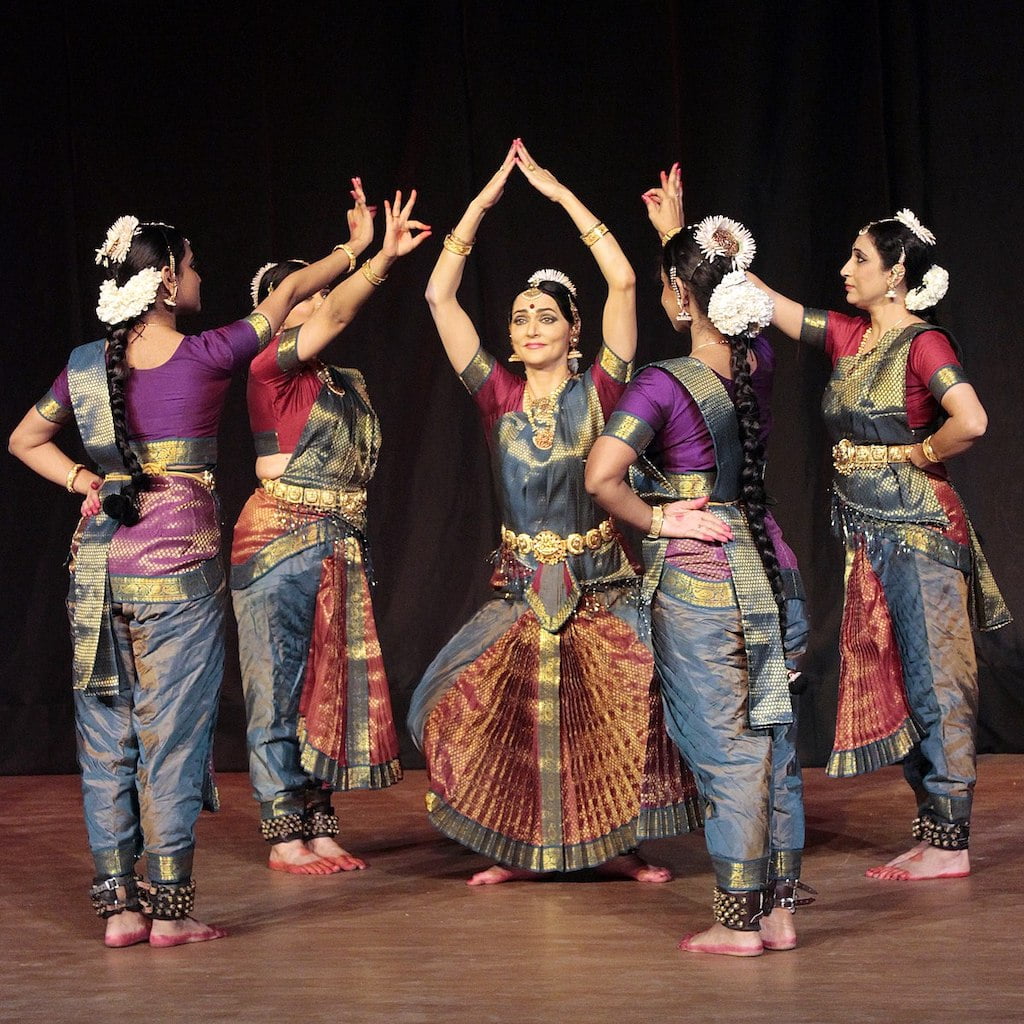
Natya: The Dance Drama
Natya encompasses the narrative dimension of Bharatanatyam, merging dance, music, and drama. It involves the enactment of dance dramas (vakyartha abhinaya) where the dancer assumes different roles, depicting characters from mythological stories, epics, or literary works. Natya incorporates dialogues (slokas), sung verses (pada), and complex choreography to tell elaborate stories. The dancer’s ability to seamlessly transition between characters, seamlessly blending dialogue, expressions, and movements, creates a compelling and immersive theatrical experience.
Integration of Nritta, Nritya, and Natya
Bharatanatyam harmoniously combines the elements of nritta, nritya, and natya in its performances. A typical Bharatanatyam repertoire, known as the “margam,” follows a structured progression. It begins with a nritta-based piece called alarippu, which showcases the dancer’s technical prowess. The performance then transitions into nritya-based pieces like jatiswaram and varnam, which explore both rhythmic patterns and expressive elements. The margam concludes with natya-based pieces such as padams, javalis, and tillanas, where the dancer assumes different characters and tells engaging stories through dance.
Bharatanatyam is a multidimensional art form that seamlessly weaves together the technical precision of nritta, the emotive expressions of nritya, and the narrative richness of natya. This integration of elements creates a captivating and holistic experience for both performers and audiences alike. Bharatanatyam’s ability to transcend boundaries and touch hearts through its expressive storytelling is what makes it a cherished and celebrated classical dance form.
The Aesthetics of Bharatanatyam: Costumes, Makeup, and Jewellery
Bharatanatyam, known for its visual splendour and vibrant aesthetics, incorporates elaborate costumes, intricate makeup, and dazzling jewellery. These elements not only enhance the visual appeal but also contribute to the storytelling and character portrayal within the dance form. Let’s explore the captivating aesthetics of Bharatanatyam.
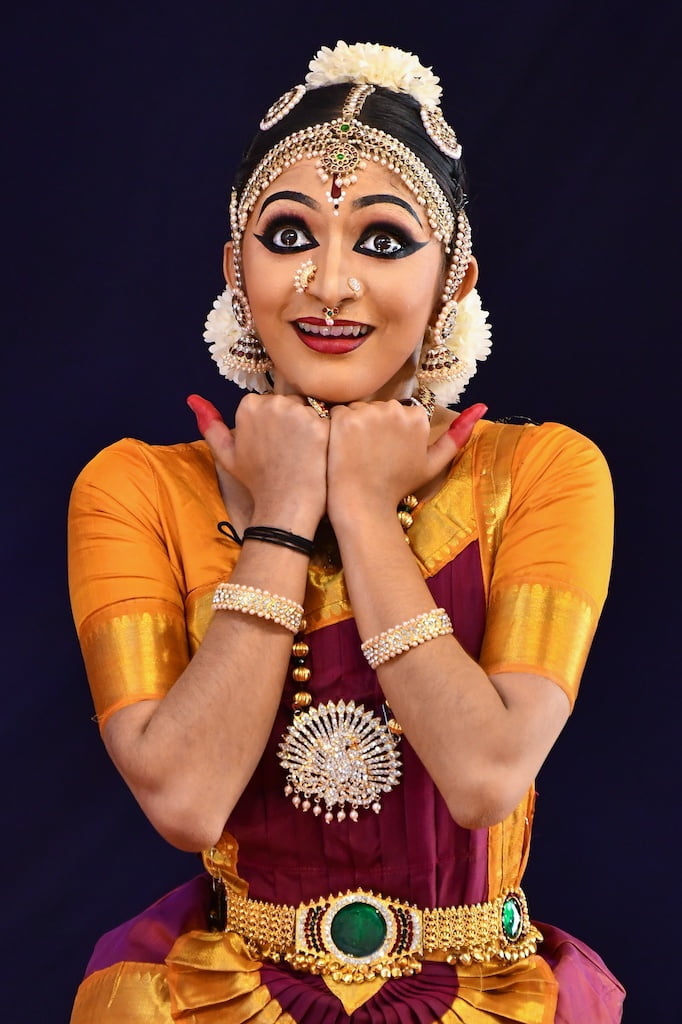
Costumes
The traditional costume worn in Bharatanatyam is a vibrant silk saree for female dancers and a dhoti or a veshti (a draped garment) for male dancers. The saree, known as the “Madisar” or “Nine-yard saree,” is meticulously pleated to allow freedom of movement. The pleats accentuate the footwork and rhythmic patterns, while the flowing pallu adds elegance to the dancer’s movements. The colors and designs of the saree vary, often reflecting regional traditions and personal preferences.
Makeup and Adornments
Makeup plays a vital role in Bharatanatyam, highlighting facial expressions and ensuring visibility under stage lights. The makeup technique involves the application of vibrant hues, including red, black, and white, to emphasize the eyes, eyebrows, and lips. The eyes are accentuated with bold lines and expressive eyebrows to convey various emotions effectively. Additionally, the lips are adorned with a bold red shade to enhance facial expressions.
Jewellery
Jewellery holds immense significance in Bharatanatyam, adding grace and enhancing the overall visual appeal of the dancer. The jewellery worn by female dancers includes:
Headpiece (Maang tikka or Nethi Chutti): An ornamental piece worn on the forehead, usually embellished with stones or pearls, that accentuates the facial features.
Earrings (Jimikki): Elaborate earrings that sway with the dancer’s movements, often featuring intricate designs and gemstones.
Necklaces (Mangalsutra or Kempu Malai): Multiple layers of necklaces, each with its own distinct design, varying lengths, and embellishments.
Waistbelt (Odiyanam or Vaddanam): A waist ornament with intricate designs that highlights the waist movements and adds elegance to the dancer’s stance.
Armlets (Vanki): Broad, intricately designed armlets worn on the upper arm, often featuring motifs inspired by nature or mythology.
Anklets (Ghungroo or Salangai): Multiple rows of bells that create rhythmic sounds with the foot movements, adding musicality to the dance.
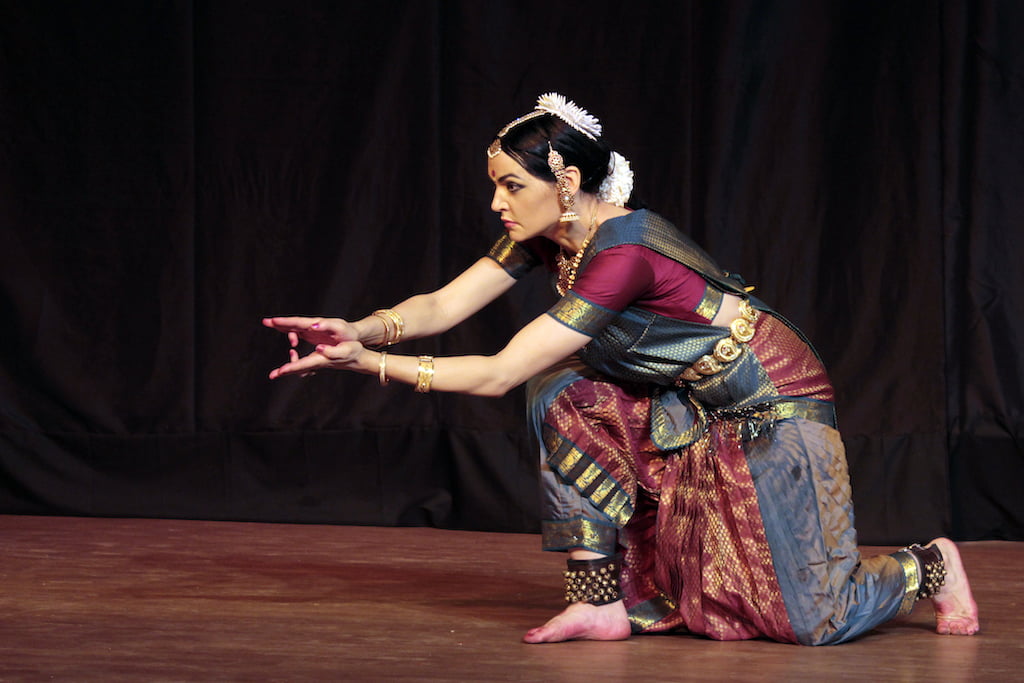
Adornments
In addition to jewellery, Bharatanatyam dancers also adorn themselves with accessories such as bells (Kuchchu), toe rings (Metti), and decorative hairpieces (Poola Jada or Veni) that enhance their overall appearance and authenticity.
The costumes, makeup, and jewellery in Bharatanatyam not only enhance the aesthetics but also contribute to the storytelling and character portrayal. They help to distinguish various roles, evoke the cultural context, and add a touch of splendour to the performances.
The intricate costumes, elaborate makeup, and dazzling jewellery of Bharatanatyam contribute to the visual grandeur and cultural richness of this classical dance form. They serve as an integral part of the dancer’s expression, augmenting the storytelling and bringing the characters to life. The aesthetics of Bharatanatyam are a testimony to the artistry, attention to detail, and the sublime beauty that captivates both the eyes and the soul of the audience.
Music and Musical Instruments in Bharatanatyam
Bharatanatyam is intimately intertwined with Carnatic music, a classical music tradition from South India. The music, with its melodic richness and rhythmic intricacy, serves as the backbone of Bharatanatyam, providing a musical framework for the dancer’s movements and expressions. Let’s delve into the music and musical instruments that accompany Bharatanatyam.
Carnatic Music
Carnatic music, rooted in ancient scriptures and classical compositions, provides the melodic and rhythmic foundation for Bharatanatyam. It comprises a vast repertoire of ragas (melodic scales), talas (rhythmic cycles), and compositions that range from soul-stirring melodies to lively rhythmic patterns. The musical compositions used in Bharatanatyam performances are typically in the Telugu, Tamil, or Sanskrit languages, drawing inspiration from mythological stories, devotional poetry, and literary works.
Vocal Music
The vocal music in Bharatanatyam is performed by a skilled Carnatic vocalist who sings the compositions known as Varnams, Keertanas, and Padams. The vocalist provides the melodic structure and lyrical interpretation, complementing the dancer’s movements and expressions. The dynamic interaction between the dancer and the vocalist adds depth and emotional nuance to the performance, creating a harmonious connection between music and dance.
Musical Instruments
Various musical instruments accompany Bharatanatyam, enriching the auditory experience and adding layers of rhythm and melody. Some of the prominent musical instruments used in Bharatanatyam include:
Mridangam: The primary percussion instrument in Carnatic music, the mridangam is a double-headed drum played with the hands. It provides intricate rhythms and serves as the backbone of the rhythmic elements in Bharatanatyam.
Violin: The violin, with its versatility and melodic capabilities, plays a crucial role in Bharatanatyam. It provides the melodic support and improvisations, adding depth and emotional expression to the performance.
Flute: The soulful sound of the flute, with its graceful melodies, enhances the melodic beauty of Bharatanatyam. It often accompanies expressive pieces, adding a touch of serenity and lyrical charm to the performance.
Veena: The veena, a traditional stringed instrument, lends a rich and resonant tone to Bharatanatyam. Its deep, melodic notes evoke a sense of grandeur and add a traditional flavor to the performance.
Cymbals (Talam): The rhythmic element is further enhanced by the rhythmic clashing of cymbals by the dancer or accompanying percussionists. The cymbals punctuate the rhythmic patterns and provide emphasis during specific movements.
The seamless coordination and interplay between the dancer, vocalist, and accompanying musicians create a cohesive musical tapestry that elevates the emotional and aesthetic impact of Bharatanatyam performances.
Collaboration and Synergy
In Bharatanatyam, the dancer, vocalist, and musicians collaborate closely, responding to each other’s cues and improvisations. This synergy between the performing artists enhances the overall artistic experience, allowing for spontaneous exchanges and creative interpretations within the framework of the traditional compositions.
Bharatanatyam’s close association with Carnatic music and the skilled use of musical instruments create a dynamic and enchanting performance experience. The melodic and rhythmic elements of the music provide the canvas upon which the dancer paints their emotions, expressions, and storytelling. The collaboration between the dancer and the musicians adds depth, beauty, and a sense of unity to the art form, making Bharatanatyam a mesmerizing synthesis of music and dance.
Training and Learning Bharatanatyam
Bharatanatyam is a complex and rigorous art form that requires years of dedicated training and practice. Let’s explore the process of learning Bharatanatyam and the training techniques involved.
Guru-Shishya Parampara
Traditionally, Bharatanatyam is taught in the Guru-Shishya Parampara, a teacher-disciple lineage that emphasizes personalized instruction and one-on-one guidance. The Guru, an experienced practitioner of Bharatanatyam, imparts knowledge, technique, and artistic interpretation to the Shishya (student). This traditional method ensures the preservation of the dance form’s essence and allows for the transmission of subtle nuances that cannot be easily conveyed through written texts.
Adavus and Basic Movements
The foundation of Bharatanatyam training lies in mastering adavus, the basic dance units that encompass a range of footwork, body movements, and hand gestures. Adavus form the building blocks for more complex choreography and help develop the dancer’s strength, flexibility, and coordination. Students spend considerable time perfecting each adavu, gradually progressing from simple to intricate sequences.
Abhinaya: Expressional Training
Abhinaya, the art of expressive storytelling, is a crucial aspect of Bharatanatyam. Students receive training in facial expressions (mukhajabhinaya), hand gestures (hastas), eye movements (drishti), and body language (angika abhinaya). The Guru guides the student in understanding the emotions behind each movement and in portraying various characters, allowing for a deep connection with the audience.
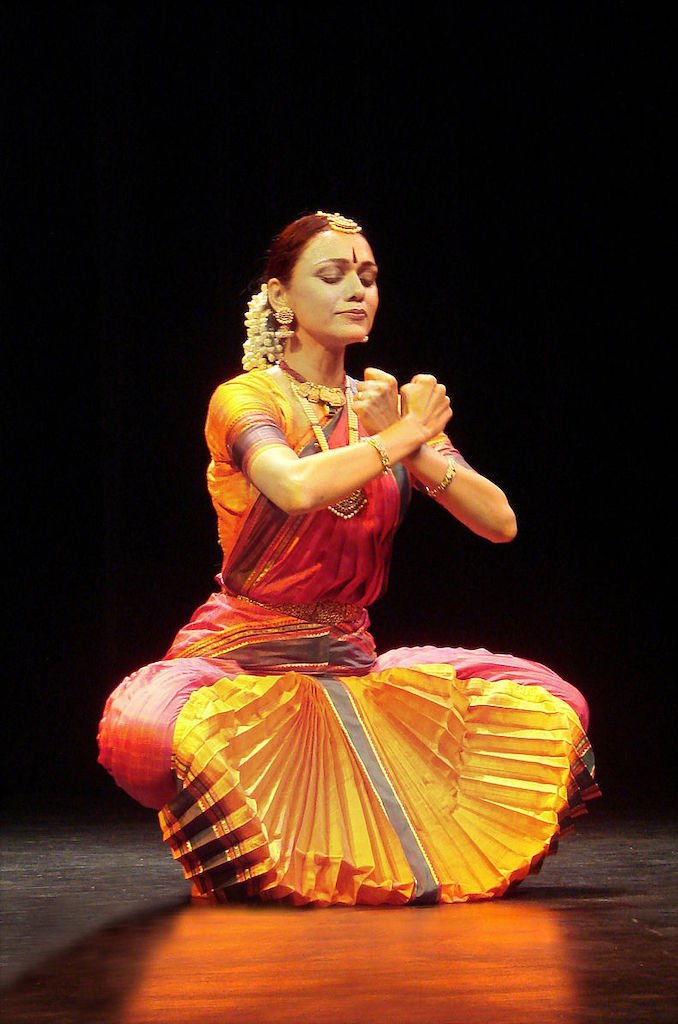
Rhythm and Tala
A strong sense of rhythm is essential for Bharatanatyam. Students learn to internalize the rhythmic patterns and time cycles (tala) through vocal recitation, clapping, and footwork. They develop an understanding of complex rhythmic structures, such as adi tala and rupaka tala, and learn to synchronize their movements with the beats. This rhythmic training builds precision and coordination in the dancer’s performance.
Repertoire and Choreography
As students progress in their training, they learn compositions and choreographies that form the repertoire of Bharatanatyam. The Guru teaches compositions such as varnams, padams, and tillanas, selecting pieces that showcase the student’s skills and provide opportunities for artistic expression. Students learn the intricacies of each composition, memorizing the lyrics, understanding the meaning, and embodying the essence of the piece through their dance.
Stage Performance and Continual Learning
Regular stage performances are integral to the learning process in Bharatanatyam. Students gain confidence, stage presence, and experience in performing for live audiences. They receive feedback and guidance from their Guru, enabling them to refine their technique, expression, and overall stage presentation. Additionally, dancers continue to learn and expand their repertoire even after years of training, attending workshops, participating in collaborative projects, and seeking inspiration from senior artists.
Learning Bharatanatyam is a comprehensive and lifelong journey. The Guru-Shishya relationship, combined with disciplined practice, fosters the development of technical proficiency, expressive abilities, and an understanding of the rich cultural heritage associated with this art form. Through years of training, Bharatanatyam dancers imbibe the intricacies of the dance, embodying its grace, depth, and artistic brilliance.
Bharatanatyam and its Cultural Significance
Beyond its artistic beauty, Bharatanatyam holds deep cultural significance and plays a pivotal role in preserving and showcasing the cultural heritage of India. Let’s explore the cultural importance of Bharatanatyam.
Historical and Mythological Roots
Bharatanatyam traces its origins back to ancient temples of South India, where it was performed as a devotional art form. The dance form draws inspiration from Hindu mythology, epics like the Ramayana and Mahabharata, and ancient texts such as the Natya Shastra. It is deeply rooted in Indian spirituality, serving as a means of connecting with the divine and expressing devotion.
Cultural Identity
Bharatanatyam is not only an art form but also an embodiment of Indian culture and identity. Through its expressive storytelling, the dance form showcases the rich cultural narratives, values, and traditions of India. It serves as a medium to pass down cultural heritage from one generation to another, fostering a sense of pride and belonging among communities.
Language and Literature
The compositions used in Bharatanatyam performances are often in languages like Tamil, Telugu, and Sanskrit. By incorporating these languages, Bharatanatyam contributes to the preservation and promotion of regional languages and classical literature. The dance form brings to life the verses of great poets, allowing audiences to appreciate the beauty of ancient texts and literary works.
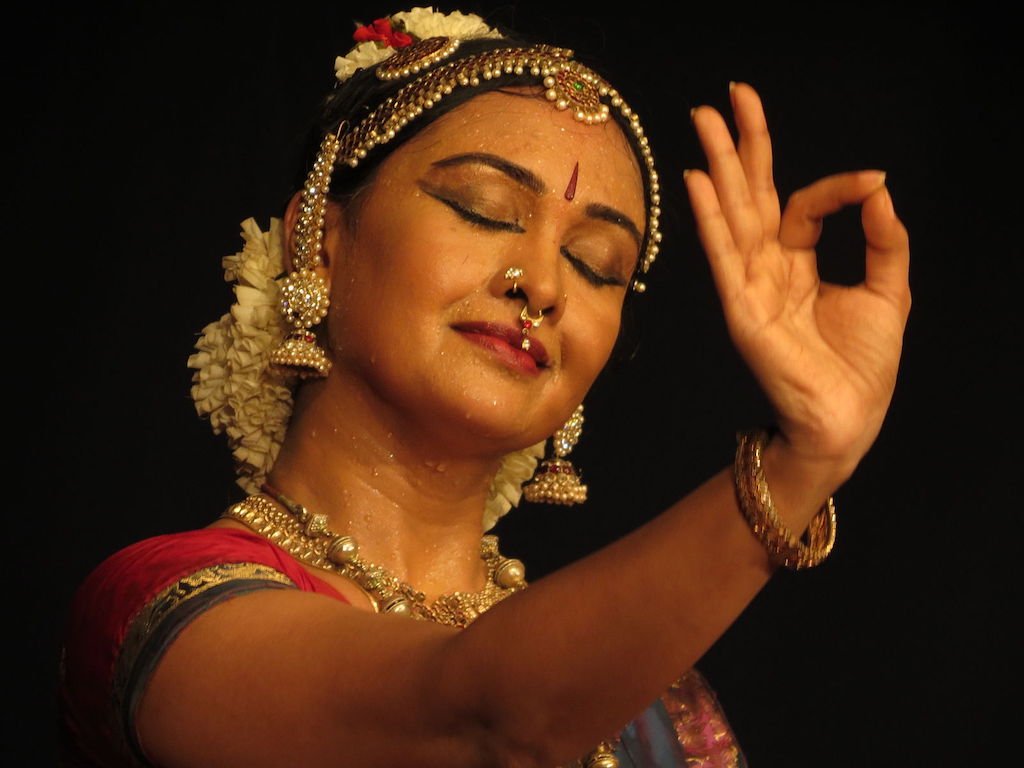
Social Commentary
Bharatanatyam has the power to convey social, moral, and ethical messages. Through its narratives and expressions, the dance form addresses societal issues, such as gender dynamics, social justice, and human emotions. Bharatanatyam artists have historically used their platform to raise awareness and spark conversations around important social issues.
Festivals and Celebrations
Bharatanatyam is an integral part of cultural festivals and celebrations in India. It is prominently featured in religious festivals like Navaratri, where performances take place in temples and community gatherings. Bharatanatyam also plays a significant role in showcasing Indian culture during national events and international festivals, promoting cross-cultural understanding and appreciation.
Global Recognition
In recent years, Bharatanatyam has gained global recognition and has been embraced by artists and enthusiasts worldwide. Through international performances, collaborations, and cultural exchanges, Bharatanatyam serves as a cultural ambassador, fostering a deeper understanding and appreciation of Indian art and tradition on a global scale.
Bharatanatyam holds immense cultural significance as a repository of Indian history, mythology, language, and social commentary. It serves as a vibrant expression of the country’s cultural identity, contributing to the preservation and propagation of its diverse heritage. Bharatanatyam’s impact extends beyond the stage, connecting people, bridging cultures, and promoting dialogue, making it a cherished and revered art form of India.
Conclusion
Bharatanatyam, the revered classical dance form of India, holds immense cultural, artistic, and historical significance. We have explored various aspects of Bharatanatyam throughout this article, from its origins and evolution to its intricate techniques and expressive storytelling. Bharatanatyam’s beauty lies in its ability to seamlessly blend rhythm, movement, music, and emotion to create a captivating experience for both performers and audiences.
Bharatanatyam also plays a crucial role in cultural preservation and the perpetuation of India’s rich heritage. Through the preservation of ancient texts, transmission of cultural values, revival of forgotten traditions, and documentation of artistic expressions, Bharatanatyam safeguards the legacy of Indian culture for future generations. It serves as a custodian of cultural heritage, ensuring that the beauty, traditions, and stories of the past continue to resonate in the present and future.
Above all, Bharatanatyam remains a source of pride and cultural identity for India. It represents the nation’s artistic excellence, values, and diversity. It transcends borders, serving as a cultural ambassador on the global stage and fostering intercultural understanding and appreciation. Bharatanatyam’s significance goes beyond its artistic beauty; it resonates with the hearts and souls of those who embrace it, connecting them to their roots, heritage, and the timeless traditions of India.




